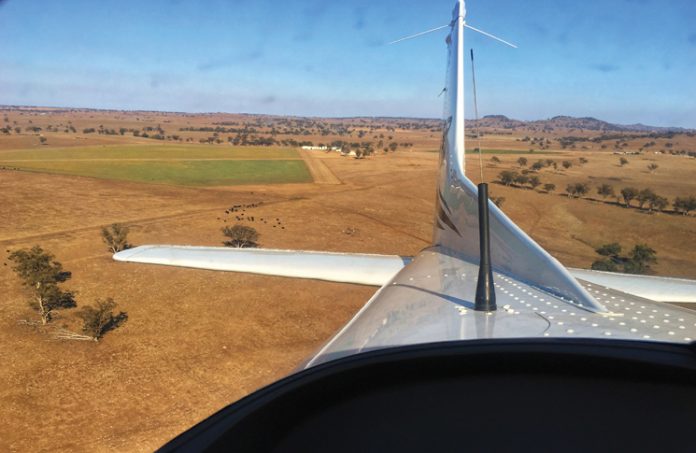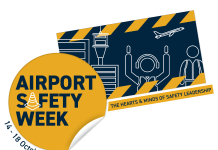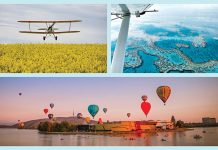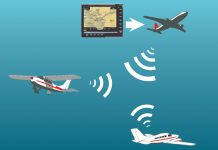By Kreisha Ballantyne
Joining an air safari will improve your skills—and the journey will be fun
In October 2008, when I was a then-GFPT student with around 50 hours of total time, I made a decision that changed the way I flew.
Having started the navigational phase of my PPL training, I decided to consolidate my navs into one giant lesson, flying from Camden to Cairns and back again as part of an air safari organised by Curtis Aviation.
In a convoy of four Cessna 182s and a Piper Warrior (who had to leave an hour earlier each day!), I travelled via Ballina and Proserpine, navigating controlled airspace, coastal weather systems and some of Australia’s most scenic beaches. For the homeward leg back to Camden, we tracked via Karumba, Adels Grove, Birdsville and Comeroo Camel Station, experiencing extensive dead reckoning, inland weather systems and some of Australia’s most barren (yet beautiful) landscape.
During that eight-day trip, I learnt the importance of properly applying the park brake on an aircraft (after I watched my poorly secured C182 roll into the back of the Warrior), how to navigate a storm cell (which led to an unscheduled landing at Cairns International Airport—also providing the lesson of how to ask ATC for advice on landing at an unscheduled airport), how to land a C182 on a dirt strip without a windsock, what do to in the case of an alternator failure in a glass cockpit aircraft (not mine, thankfully) and why remaining hydrated and well fed is integral to a good landing.
Along with an instructor and another GFPT student around the same stage as myself, our C182 covered 2800 nautical miles over eight days. It was the steepest learning curve of my life, but when I returned home, I was almost ready for my PPL test.
What I learnt on that trip set the tone for my flying for the future: in 2011, when I flew solo from Sydney to Perth and back for my CPL hours, the lessons learnt from the air safari were vital to the safety and success of that epic trip; in 2015, when I took a Cirrus on tour across NSW and Victoria, the strategies and techniques I’d garnered from the 2008 safari were just as relevant, even in a glass cockpit higher-performance aircraft.
In short, flying in a group, particularly a group that includes instructors and mixed ability pilots, is possibly one of the most valuable learning experiences a pilot can have.
The benefits of training tours
Shelley Ross, aviation travel writer, flying instructor and author of Flying the Outback, is Australia’s most celebrated air-safari expert, having experienced more than 30 over 15 years. As a long-time participant in CASA’s Out-n-Back series, she is an advocate of air safaris and group flying as a means of gaining confidence as a pilot.
After her first real safari in 2004, she immediately realised the potential for learning. ‘Ah yes, my first trip, my first glimpse of the Kimberley. It took me about three months to plan and I was so nervous on day one, I couldn’t speak, let alone eat,’ she says.
‘But a little light was ignited on that trip and I didn’t realise quite how bright that was to become. Under the guiding hand of veteran outback pilot Graham Boatman of Stawell Aviation, I learnt that getting your PPL gives you just the tip of the iceberg of knowledge that is going to keep you alive in the sky. Experience, confronting decisions and learning from your mistakes are the building blocks of a long and safe flying career. And to this day, I’m still learning. Every single day I fly, I learn something.
‘That was also the trip where I redesigned my prop on day two, doing very thorough run-ups—on stones, not moving, high power—just like it said to do in the checklist. Welcome to the outback!
‘After five safaris as a tag along with Stawell Aviation over six years, we’d covered a lot of the country and met the mob who have turned out to be our lifelong flying buddies.’
Like me, Shelley also experienced the steep learning curve of Curtis Aviation’s air safaris.
‘These Curtis trips, where students or PPLs rotate through the left-hand seat every second or third leg, taught me hands down the depth of learning that continues when you’re in a relaxed non-pilot seat,’ she says. ‘By this time, I figured we could try and give a safari a go on our own. That worked.’
Comfort in a crowd
Shelley and her colleague Catherine Fitzsimons of WardAir now specialise in designing and running carefully tailored air adventures, following a route and time frame of their choice. After dozens of training tours, Shelley and Catherine are experts in the ‘comfort in numbers’ aspect of group flying.
‘If you have engine trouble or a flat tyre or some other impediment to a happy day, you’re going to love having other pilots around you,’ Shelley says. ‘Whether it’s tools or advice or another set of hands you need, if you’re outback and in trouble, you really don’t want to be on your own. All you hardcore bush pilots can say what you want, but I’ve watched it over 15 years and everybody always helps one another out. It’s a thing.
‘Fleet flying, however, is an acquired skill and takes the utmost attention. A group of five aircraft about to arrive at the same airfield means faultless communication, a planned order of departure from the previous location (‘fastest first’ works for us), separation disciplines at the destination circuit and, quite often, patience. Taxiing and parking your fleet of five efficiently, particularly on dirt, requires etiquette, prop care and tons of common sense. Have a vat of gin handy if you’re wrangling more than six in a tight space.’
Michelle Packwood, AOPA Australia’s air safari co-ordinator, seconds Shelley’s ‘safety in numbers’ approach. In partnership with Sydney Flying Club, AOPA is planning a series of air safaris in 2020, with Michelle at the helm. Having experienced group flying in the USA, she intends to bring her passion for group learning to Australian air safaris.
‘I really want to inspire both experienced and newer aviators to come together through inclusive events and fly to learn from each other,’ she says. ‘By bringing together pilots from all walks of life—GA and recreational, it doesn’t matter what you fly—in conjunction with experienced instructors, we can create a learning experience for everyone. I truly believe this is a great way to share knowledge and experience and participating in events like this make us better educated and safer pilots.’
A culture of safety and airmanship
General aviation is a culture and pilots are part of a community. While air safaris foster the community spirit among travellers, they also promote the culture of safety and good airmanship—the aspects of aviation that cannot be learnt from a book. As one Sydney-based flying instructor says, ‘Airmanship is an attitude, a culture, and absorbing culture takes time.’
Time is one thing pilots have on an air safari. Andrew Andersen was a recent participant on an AOPA safari to the Kimberleys. Over 14 days the group travelled from Katherine to Kununarra across the outback.
‘Generally speaking, we GA pilots are a bunch of individual contributors,’ he says. ‘Unlike in the airlines, another licence holder in the cockpit usually means we’re attempting to learn something or someone is trying to determine if we actually did. Sure, often enough, two or three GA pilots fly around together, but that’s generally either to save money, be social or both.
‘So, when a dozen GA singles teamed up to fly across the country in the AOPA Kimberley air safari, the human dynamics were unusual and interesting. There were some ‘new’ pilots and some who have been at the game for decades. Some have flown the largest multi-engine jets over oceans, while for others, an air safari across our country’s single continent marked a first in long distance and probably the longest number of consecutive days they had been flying as pilot in command—women and men, senior and younger, city and country—a mixed demographic with widely ranging interests outside aviation, tastes and opinions.’
Another pilot with you or in an accompanying aircraft is a huge amount of fun and a great comfort.
Is there safety in numbers?
The opportunities for learning when flying in a group arise from shared planning, observation and adjusted plans and intentions. The group learnt to work together with safety in mind, despite their ages, experience or aircraft types.
‘For example, the evening before departing for Cygnet Bay, most of the group discussed how to remain safely separated from each other and the expected scenic charter operators who would also be found on a picturesque route,’ Andrew says. ‘The desire for photography, advantages of staggered arrivals and familiarity with the area were all considered and plans made accordingly. En route, pilots checked in with each other, using radio-assisted see and avoid for separation. The fastest aircraft arrived first and their impression of the landing conditions was conveyed to the slower, later arrivals, which aided confidence and a healthy sense of caution at the remote airstrip.
‘Afterwards, at this and other destinations, pilots of the same type swapped experiences: what are the best airspeeds to use on downwind? Is full flap always required for long runways in gusty, turbulent conditions? How much fuel should be loaded at each point of departure? When is it safe to adjust the aiming point if there are tall stands of trees near a windy threshold?
‘A pilot not flying can call out runway remaining, alert to declining airspeed in a wind shear event or announce sighting another aircraft on an approach. Without such a resource, single-pilot GA demands skills way beyond technical aircraft control—skills of observation, deduction and decision-making keep their flights safe.’
Flying with a group of wide experience, backgrounds, knowledge and age brings the chance to share such non-technical skills. Whether that is around the table at dinner or a quiet word before launch with windsocks swinging wildly, or by radio in the circuit on arrival, the wise GA pilot takes in good advice and applies it to their particular flight situation.
However, it’s not just one-on-one learning. Those dinnertime conversations also build shared understanding. A group of pilots in a shared social environment can teach the group, ask questions and learn from it, all at the same time.
‘A big element in the Kimberley safari’s success was the opportunity to share and challenge ideas with like-minded people and apply them to each day’s flight challenges,’ Andersen says.
‘Like proficient instrument flying, it’s all about attitude. Pilots with bad attitudes don’t stay right side up. Misplaced competitiveness, inflated egos, pompous know-it-alls and empty-headed followers would be a recipe for disaster during group fly-away activities.
Happily, we saw none of that on the safari and safety, enjoyment and a lifetime of great memories was the result of that.’
Flying the Outback’s tips for air safaris
-
Plan ‘til you’re blue in the face. Plan for every possible scenario, particularly weather. Plan for 3 km visibility across the NT due to smoke, for a dust storm, up to 10,000 feet and for an engine failure over a desert.
-
Plan and replan your fuel. Never rely on access to fuel until you’ve spoken to a real person at the location.
-
Get current before you leave. Going into short bush strips? Do an hour of short-field circuits on an unsealed strip before day one.
-
Redundancy. As well as the G1000, an EFB and a spare handheld GPS, we never fly without current, fully marked-up paper maps and flight plan.
-
Open your eyes and listen around any CTAF or ALA. Ag aircraft will be using the most convenient runway. Chances are it’s not yours. Or farmer Joe might forget where his PTT button is.
-
Don’t be intimidated to ask for clarification. Kimberley, Kakadu, FNQ, Uluru, Lake Eyre are huge scenic flight meccas. Ask charter pilots to say again if you can’t understand them.
-
If possible, always monitor area frequency.
-
Calling into Alice? Phone the tower and get a heads-up on what to expect.
-
Calling into Darwin? It can be busy. Swat up on CTA and LAHSO procedures. And always submit a flight plan.
-
Always call time in UTC over the radio. Always. (In SA and NT, this will save you a world of pain.)
-
Go with another pilot. No matter how much experience you have, another pilot with you or in an accompanying aircraft is a huge amount of fun and a great comfort.
Don’t rely on others for your decision-making. In the quiet of your room, make your choices for that day’s flying based on your own study of weather, endurance and airstrips. Peer pressure may be unintentional, but it’s real. Certainly, listen to what other pilots share around the table, there may be some useful tips to learn, but use your discretion about adopting a different method of operating.
But best tip of all—just get out there and give it a go. We promise you’re never look back.













But she never did get that CPL.
All true. I did most of my Navs in a 172 which we bought from the NSW Scouts association with all the minimum equipment , same as yours. Nonetheless it was good experience and taught you all the hard yards!
How very true Walter, those days were hetic submit flt plans if yr flt was more than 50 nm , Full reporting , the regulator watched us like a hawk.,today is very different , the rules have been relaxed ! the cost of flying has grounded many pillots , including myself . BFRS,, Medicals, security, aircraft hire, fuel, landing fees , charts . all that is a strain on your enthusiasim to keep involved , and its a shame, because we all love tu fly.. its the ultimate thing to do.. now, at the end of the artical , it says
{get out and have a go ] but it all comes down to the cost. i,ve been having a go for yrs , but it doesn,t seem worth the effort the way things are today. And walter , your comments remind me of myself, we must be from the same era . SAFE FLYING.
All above.”Yeah” those were the days.Luckily for me I did get to do my most of my early nav’s,in a 182,albeit an early model one with a square tail and no panoramic windows.no autopilot and ,no GPS’.It had one VHF radio and HF radio.I went right up a CPL in that aircraft. I did manage to have a complete set of “new” WAC charts,so did not have to deal with the chinograph pencil tracks that were often left on the the charts used by the other users,that were not completely cleaned off.Those were the days when the regulator was who was called the Dept of Civil Aviation was staffed by mostly aviation minded EX Military pilots,who had the same attitudes as ourselves. They cared about the community of pilots out here and as Walter has said watched us like hawks,not to really hound as they do nowadays,but to make sure we carried out our
passion safely.and enjoyably. i am proud to say that I came up the same way as many like Walter did and I really can say that I think I learned a lot about flying,not like these days as a cash cow for the flying schools that now operate,who main purpose is to train you to pass a licence,not learn to fly.
I forgot to mention that the 182 referred to above was what they called back in those days “IFR equipped, as in it also had an ADF ,a VOR and a DME .As at that time in my training I was not fully trained to use them;so I did not use them until I started my CPL training
Congratulations Kreisha, your article is one of the best that I have read on bush flying techniques and airmanship. I have flown in all the areas you mention many times over many years and all the advice you give is spot on!
Great stuff Kreisha.